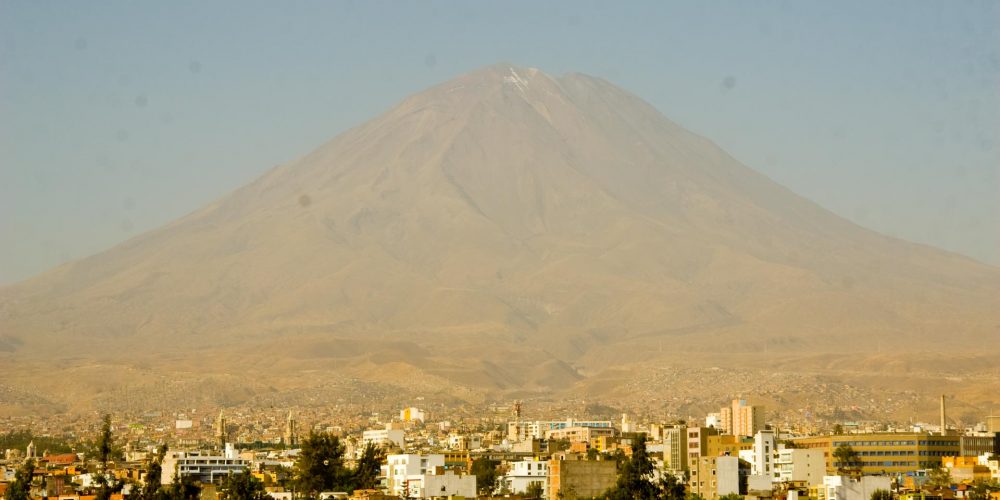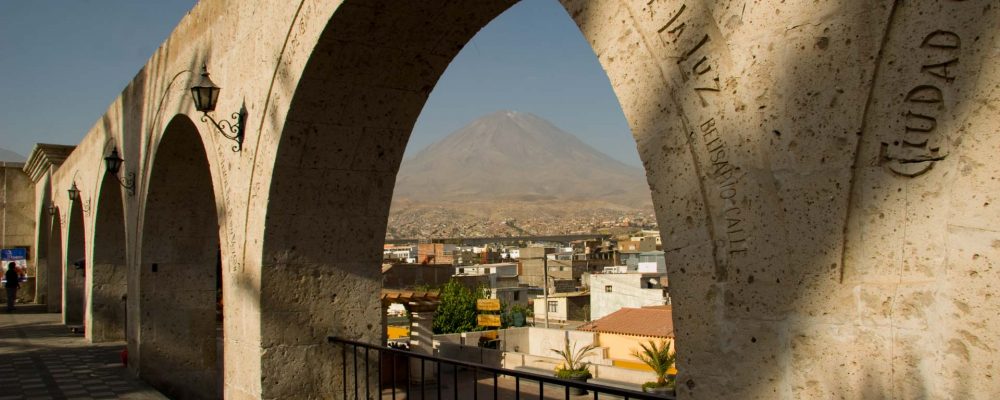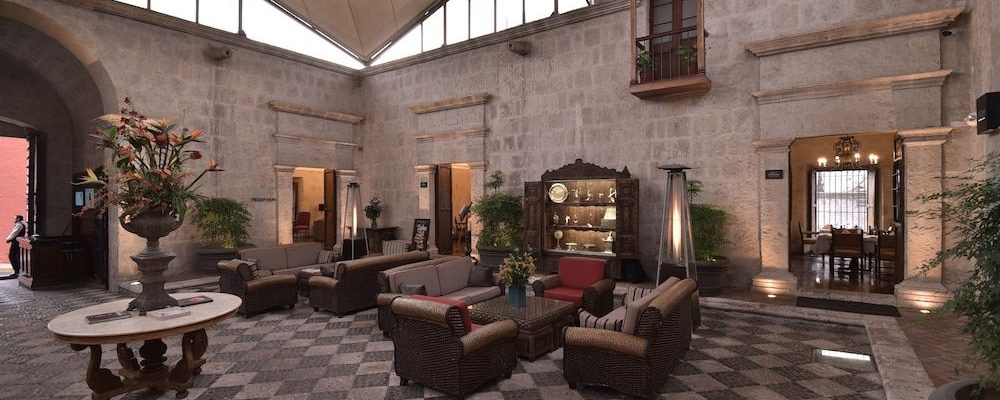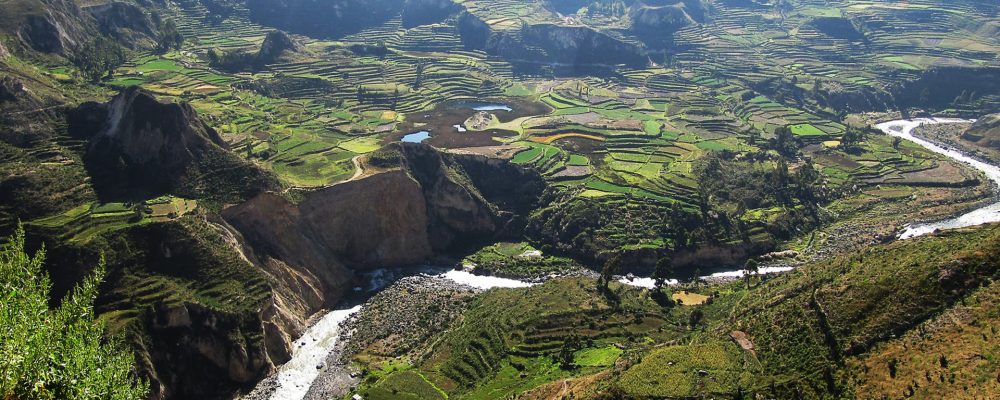Arequipa
Arequipa is a vibrant and historically rich city located in southern Peru. Known as the “White City” due to the prevalent use of white volcanic stone in its colonial architecture, Arequipa is the second-most populous city in the country and the capital of the Arequipa Region. Situated at an altitude of approximately 2,335 meters (7,661 feet) above sea level, the city is surrounded by stunning landscapes, including the Andes Mountains and the Chachani, Misti, and Pichu Pichu volcanoes.

Table of Contents
Overview
Arequipa, a city nestled in the highlands of southern Peru, is a captivating blend of colonial charm and breathtaking natural beauty. Known as the “White City” for its distinctive architecture crafted from volcanic white sillar stone, Arequipa boasts a UNESCO-listed historic center that showcases a rich cultural and architectural heritage. Dominated by the majestic Misti Volcano as its backdrop, the city is surrounded by dramatic landscapes, including the stunning Colca Canyon, one of the world’s deepest canyons. Arequipa’s culinary scene is equally impressive, with a diverse array of delicious Peruvian dishes to savor. The city’s warm climate, friendly locals, and vibrant markets contribute to its unique allure, making Arequipa a must-visit destination for travelers seeking a blend of history, culture, and natural wonders.
History

Arequipa, often referred to as the “White City” due to the predominant use of white volcanic rock in its architecture, is the second-largest city in Peru and is located in the southern part of the country. The city has a rich history that dates back thousands of years, with evidence of human settlement in the region dating as far back as 10,000 BC.
Pre-Columbian Era:
Before the arrival of the Spanish conquistadors in the 16th century, the region around Arequipa was inhabited by various indigenous cultures, including the Wari and the Collagua. These cultures left behind archaeological sites and artifacts that provide glimpses into their way of life.
Spanish Conquest and Colonial Period:
Arequipa was founded by the Spanish conquistador Garcí Manuel de Carbajal on August 15, 1540. The city quickly grew in importance due to its strategic location as a trade and transit hub between Lima and Cuzco. Arequipa became a major center for mining, agriculture, and trade during the colonial period.
The city’s architecture reflects a unique blend of Spanish and indigenous influences. Many of the colonial-era buildings were constructed using sillar, a white volcanic rock abundant in the region, giving Arequipa its distinctive appearance.
Independence and Republican Era:
During the struggle for independence in the early 19th century, Arequipa played a significant role. The city was a center of both pro-independence and royalist sentiments, and it experienced periods of conflict and political instability. Arequipa eventually became part of the independent Republic of Peru when the country gained its freedom from Spanish rule in 1821.
Economic Development:
In the late 19th and early 20th centuries, Arequipa experienced economic growth and modernization. The city became an important industrial and commercial center, with a focus on textiles, agriculture, and manufacturing. The development of infrastructure, such as railways and roads, further facilitated economic activities in the region.
20th Century to Present:
Arequipa continued to evolve throughout the 20th century, with ongoing economic and social changes. The city has maintained its cultural richness and architectural heritage, leading to its designation as a UNESCO World Heritage Site in 2000.
Today, Arequipa is known not only for its historical significance but also for its vibrant culture, culinary traditions, and as a gateway to the stunning landscapes of the Colca Canyon and the surrounding Andes mountains. The city’s historical center, with its colonial-era buildings and churches, remains a focal point for tourists and locals alike, showcasing the enduring legacy of Arequipa’s captivating history.
Things to do
Certainly! Arequipa is a beautiful city in Peru with a rich cultural heritage and stunning landscapes. Here are some things to do in Arequipa:
Santa Catalina Monastery:
Explore the Santa Catalina Monastery, a stunning complex of colonial buildings that dates back to the 16th century. Wander through its narrow streets, vibrant courtyards, and learn about the history of this well-preserved convent.
Plaza de Armas:
Visit the main square, Plaza de Armas, surrounded by impressive colonial buildings and the iconic Basilica Cathedral of Arequipa. The square is a great place to people-watch, enjoy local snacks, and take in the atmosphere.
Museo Santuarios Andinos:
Discover the Museo Santuarios Andinos, where you can learn about Inca culture and see the famous mummy “Juanita,” a well-preserved Inca girl who was sacrificed on a nearby mountain.
Yanahuara and Cayma Miradors:
Head to the districts of Yanahuara and Cayma to enjoy the beautiful miradors (viewpoints) that offer panoramic views of the city and the surrounding volcanoes, including Misti, Chachani, and Pichu Pichu.
Arequipa’s Culinary Scene:
Indulge in the local cuisine. Arequipa is known for its delicious food, including traditional dishes like rocoto relleno (stuffed spicy pepper), adobo (marinated meat), and the famous rocoto relleno.
Sabandia Mill and Mansion:
Take a trip to the Sabandia Mill and Mansion, a historic site surrounded by beautiful gardens and water features. The mill dates back to the 17th century and offers a glimpse into Arequipa’s agricultural history.
Colca Canyon:
Embark on a day trip to Colca Canyon, one of the deepest canyons in the world. Enjoy breathtaking landscapes, spot Andean condors, and experience the local culture in the traditional villages along the way.
Explore the Historic District:
Stroll through the historic district and admire the well-preserved colonial architecture. Don’t miss the Claustros de la Compañía, a complex of courtyards and halls that once belonged to the Jesuit order.
Sillar Route:
Take a Sillar Route tour to witness the impressive quarries where the white volcanic stone, sillar, is extracted. Learn about the traditional methods of stone carving and their importance in shaping the city’s architectural identity.
Visit the Arequipa Anthropology Museum:
Gain insights into the region’s cultural history by visiting the Arequipa Anthropology Museum, which houses artifacts and exhibits showcasing the diverse heritage of Peru.
Whether you’re interested in history, culture, or outdoor adventures, Arequipa has something to offer for every traveler.
Hotels

Arequipa, a picturesque city nestled in the Andes of southern Peru, is known for its rich cultural heritage, stunning colonial architecture, and vibrant culinary scene. When it comes to accommodation in Arequipa, there are various hotels catering to different preferences and budgets. Here’s a brief overview of hotels in Arequipa:
Casa Andina Private Collection Arequipa:
Located near the Santa Catalina Monastery, this upscale hotel offers a blend of colonial architecture and modern amenities. The rooms are well-appointed, and guests can enjoy the courtyard, spa, and on-site restaurant.
Hotel Libertador Arequipa:
Overlooking the Plaza de Armas, Hotel Libertador provides a central location and luxurious accommodations. The hotel features spacious rooms, a rooftop terrace with panoramic views of the city, and a restaurant serving Peruvian cuisine.
Sonesta Hotel Arequipa:
Situated in the financial and residential district of Arequipa, the Sonesta Hotel offers comfortable rooms, a rooftop terrace with a pool, and a restaurant serving both local and international dishes.
Casa Andina Select Arequipa Plaza:
Another property from the Casa Andina chain, this hotel is centrally located and provides a more mid-range option. The rooms are comfortable, and guests can enjoy amenities such as a terrace, gym, and on-site restaurant.
Tierra Viva Arequipa Plaza Hotel:
This hotel is known for its excellent location near the main square and the Santa Catalina Monastery. It offers modern and cozy rooms, a terrace with city views, and a complimentary breakfast.
Hotel Katari Boutique:
For those looking for a boutique experience, Hotel Katari offers stylish and individually decorated rooms. The hotel is within walking distance of many attractions, and guests can enjoy the rooftop terrace with beautiful views of the city.
Posada del Monasterio:
This charming hotel is located just a few steps from the Santa Catalina Monastery. It has a colonial-style courtyard, comfortable rooms, and a peaceful atmosphere.
Selina Arequipa:
Selina is a trendy and modern option, offering a combination of private and shared accommodations. With a vibrant atmosphere, co-working spaces, and a bar, Selina caters to a diverse range of travelers.
Whether you’re seeking luxury, boutique charm, or a budget-friendly stay, Arequipa’s hotels provide a variety of options for visitors to experience the city’s unique culture and attractions.
Restaurants
Arequipa, the picturesque city located in southern Peru, is not only known for its stunning colonial architecture and rich cultural heritage but also boasts a vibrant culinary scene. The city’s diverse gastronomy reflects a blend of indigenous ingredients, Spanish influence, and modern culinary innovation. Here’s a glimpse into the culinary delights offered by the restaurants in Arequipa:
Zig Zag Restaurant:
Location: Santa Catalina 210, Arequipa
Description: Zig Zag is a renowned restaurant that combines traditional Peruvian flavors with international culinary techniques. Set in a beautifully restored colonial house, the restaurant offers a cozy and elegant atmosphere. The menu features a variety of dishes showcasing the region’s fresh ingredients, including seafood and local produce.
Chicha por Gastón Acurio:
Location: Santa Catalina 210, Arequipa
Description: Chicha, part of the Gastón Acurio restaurant group, brings a modern twist to traditional Peruvian cuisine. The menu highlights local ingredients and traditional recipes, presenting them in a contemporary and creative manner. The restaurant’s commitment to sustainability is reflected in its use of organic and locally sourced products.
La Nueva Palomino:
Location: Calle Santa Catalina 210, Arequipa
Description: La Nueva Palomino is a popular spot for those seeking authentic Arequipeñan cuisine. Known for its hearty portions and friendly atmosphere, the restaurant specializes in traditional dishes such as rocoto relleno (stuffed spicy pepper), adobo (marinated pork), and chupe de camarones (shrimp chowder).
Sol de Mayo:
Location: Puente Grau 106, Arequipa
Description: Sol de Mayo is a charming restaurant with a focus on traditional Peruvian dishes. The menu showcases a variety of local specialties, including grilled meats, soups, and stews. The rustic ambiance and friendly service make it a favorite among both locals and tourists.
La Trattoria del Monasterio:
Location: Santa Catalina 301, Arequipa
Description: This Italian-inspired restaurant is located in the heart of Arequipa, near the Santa Catalina Monastery. La Trattoria del Monasterio offers a menu featuring a variety of pasta dishes, wood-fired pizzas, and other Italian classics. The cozy atmosphere and courtyard seating add to the overall dining experience.
Capriccio del Mare:
Location: Calle La Merced 107, Arequipa
Description: For seafood enthusiasts, Capriccio del Mare is a top choice. Specializing in fresh seafood and ceviche, the restaurant offers a delightful culinary journey with its diverse menu of Peruvian coastal dishes. The nautical-themed decor adds a touch of charm to the dining experience.
Whether you’re in the mood for traditional Arequipeñan fare, international fusion cuisine, or fresh seafood, the restaurants in Arequipa cater to a wide range of tastes, making it a must-visit destination for food enthusiasts.
Tour Packages
Travel Tips

Traveling to Arequipa, a picturesque city in Peru, offers a unique blend of historical charm, natural beauty, and cultural richness. To make the most of your visit, consider the following travel tips:
- Altitude Considerations:
Arequipa is situated at a higher altitude (over 2,300 meters or 7,500 feet). To acclimatize to the altitude, take it easy during the first couple of days, stay hydrated, and consider drinking coca tea, which is known for helping with altitude sickness.
- Best Time to Visit:
The weather in Arequipa is generally pleasant. The dry season, from May to October, is considered the best time to visit when the days are sunny and nights are cool. The wet season, from November to April, sees more rainfall.
- Must-Visit Attractions:
Santa Catalina Monastery: A stunning, vibrant convent with narrow streets and colorful buildings.
Plaza de Armas: The central square surrounded by colonial-era buildings and the imposing Cathedral.
Colca Canyon: A breathtaking natural wonder nearby, known for its depth and the Andean condors.
- Local Cuisine:
Don’t miss trying local specialties such as rocoto relleno (stuffed spicy pepper), adobo (marinated pork), and ocopa (potatoes in a spicy cheese sauce).
Explore the San Camilo Market for a taste of authentic Peruvian street food.
- Transportation:
Arequipa has a well-connected airport, Rodríguez Ballón International Airport (AQP), with flights to and from major Peruvian cities.
Taxis and public buses are common means of transportation within the city. Agree on the fare before getting into a taxi.
- Cultural Etiquette:
Learn a few basic phrases in Spanish. The locals appreciate the effort, even if you don’t speak the language fluently.
Respect local customs and traditions, especially in religious sites.
- Safety Tips:
Arequipa is generally considered safe, but like any city, be cautious of your belongings and avoid poorly lit areas at night.
Stay hydrated, use sunscreen, and wear a hat, especially when exploring outdoors due to the strong sun at high altitudes.
- Packing Essentials:
Pack layers as temperatures can vary throughout the day.
Comfortable walking shoes are essential, especially if you plan on exploring the historic center and surrounding areas.
- Local Festivals and Events:
Check for local festivals or events happening during your visit. These celebrations provide a unique glimpse into the culture and traditions of Arequipa.
Arequipa’s unique blend of history, culture, and natural beauty make it a must-visit destination in Peru. With these tips in mind, you can make the most of your time exploring this charming city.
FAQ´s
Certainly! If you’re planning to visit Arequipa, a charming city in southern Peru, you might find the following Frequently Asked Questions (FAQ) helpful for your trip:
Arequipa is renowned for its well-preserved colonial architecture, including the stunning Santa Catalina Monastery. The city is also surrounded by breathtaking landscapes, including the nearby Colca Canyon, one of the deepest canyons in the world. Arequipa is often called the “White City” due to the widespread use of white volcanic stone in its architecture.
You can reach Arequipa by air through Rodríguez Ballón International Airport (AQP), which is well-connected to major cities in Peru. Alternatively, you can take a bus from other Peruvian cities, offering a scenic journey through the country.
The weather in Arequipa is generally mild, but the best time to visit is during the dry season from April to November. This period ensures clear skies and pleasant temperatures, making it ideal for exploring the city and its surroundings.
Santa Catalina Monastery: A beautiful, historic monastery that provides insight into the city’s colonial past.
Plaza de Armas: Arequipa’s main square surrounded by impressive colonial buildings, including the Cathedral.
Colca Canyon: A natural wonder near Arequipa, known for its stunning landscapes and the Andean condors that can be seen soaring in the canyon.
Rocoto Relleno: A spicy dish made from stuffed red peppers.
Adobo: Marinated pork or beef, slow-cooked with spices and chili.
Queso Helado: A local ice cream with a unique texture, traditionally made with flavors like cinnamon and coconut.
Arequipa is generally safe for tourists, but like any city, it’s advisable to take basic precautions. Be aware of your surroundings, avoid poorly lit areas at night, and keep an eye on your belongings.
Arequipa is at a higher altitude (around 2,335 meters or 7,661 feet), so it’s recommended to take it easy for the first day to acclimate. Drink plenty of water and avoid heavy meals.
Consider taking guided tours to Colca Canyon, Misti Volcano, and other nearby attractions. Many agencies in Arequipa offer both group and private tours.
These FAQs should help you plan a memorable trip to Arequipa. Enjoy your visit.




